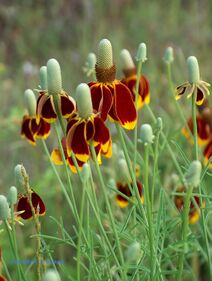Ratibida columnifera
| Ratibida columnifera | |
 | |
| Light: | |
| Moisture: | |
| Hardiness: | 3 |
| Soil pH: | 5.6-8.4 |
| Height: | 2' |
| Blooms: | Early Fall |
| Native to: | |
| Nectary | |
| Edible Rating: | |
| Medicinal Rating: | |
| Tea: | Yes |
Ratibida columnifera (common names: prairie coneflower and Mexican hat)
Preferring sunny, dry, and open spaces where intense reds and yellow petals blossom by the thousands, this fast growing flower establishes itself relatively quickly from seed. While long lasting blooms attract short tongued bees and the occasional butterfly or skipper, the foliage has a scent that repeals deer. Drought tolerant due to a strong taproot, sombrero shaped flowers grow from upright woody stems.
Propagation: Seed - we have no information for this species but suggest sowing the seed in a cold frame in early spring. Only just cover the seed and put the pot in a sunny position. When they are large enough to handle, prick the seedlings out into individual pots and plant them out in early summer.
Division in spring is possible but very difficult because the plant has a long taproot[1].
Cultivation: Prefers a sunny well-drained border of fairly rich soil[2]. Established plants are extremely drought tolerant[1].
A very ornamental plant[2].
Although perennial, plants are sometimes grown as annuals, they flower in their first year from seed[1].
Range: Western N. America - British Columbia to Montana, Nebraska, Texas, New Mexico and Mexico.
Habitat: Dry plains, prairies and ravines[3]. Sandy, silty, or rocky open ground in Texas[4].
Edibility: A pleasant tasting tea is made from the leaves and flower heads[5][6][7][8].
Medicinal: The leaves and stems are analgesic[8]. An infusion is used to relieve the pain of headaches and to treat stomach aches and fevers[8]. A decoction is used as a wash to relieve pain and to treat poison ivy rash[8]. The decoction is also used as a wash to draw the poison out of a rattlesnakes bite[8].
Pollinators: Insects
Soil: Can grow in light, medium, and heavy soils.
Drainage: Prefers well drained soil.
Flower Type: Hermaphrodite
Also Known As: R. columnaris. Lepachys columnaris.
Links
References
- ↑ 1.0 1.1 1.2 Huxley, Anthony. The New Royal Horticultural Society Dictionary of Gardening. MacMillan Press, 1992.
- ↑ 2.0 2.1 Chittendon, Fred. RHS Dictionary of Plants. Oxford University Press, 1951.
- ↑ Lyndon, Merritt. Gray's Manual of Botany. American Book Co, 1950.
- ↑ Diggs, George and Barney Lipscomb. Illustrated Flora of North Central Texas. Botanical Research Institute, 1999.
- ↑ Yanovsky, Elias. Food Plants of the North American Indians Publication 237. US Department of Agriculture.
- ↑ Kunkel, Günther. Plants for Human Consumption. Koeltz Scientific Books, 1984.
- ↑ Facciola, Stephen. Cornucopia - A Source Book of Edible Plants. Kampong Publications, 1990.
- ↑ 8.0 8.1 8.2 8.3 8.4 Moerman, Daniel. Native American Ethnobotany. Timber Press, 1998.